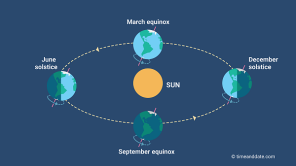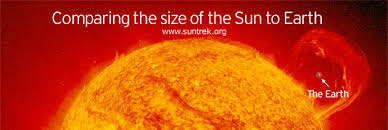Autumn Equinox Celebration 2022
This year the moment of equal day and night happens on Thursday, September 22 in the US. It will signal autumn in the Northern Hemisphere and spring in the Southern. Although climate chaos has altered weather patterns everywhere, the seasons — if not the expected weather — remain consistent. The following applies to Autumn Equinox. (For those entering Spring, please check out sites (including this one) for spring celebrations, or adapt this one
autumn in the Northern Hemisphere and spring in the Southern. Although climate chaos has altered weather patterns everywhere, the seasons — if not the expected weather — remain consistent. The following applies to Autumn Equinox. (For those entering Spring, please check out sites (including this one) for spring celebrations, or adapt this one
This image gives the general idea, but is vastly out of proportion. See the image below for a better idea of Earth’s size compared to the Sun’s.
BACKGROUND: ANCIENT AWARENESS
The word equinox dates to the 14th century. Celebrations of this event can be traced to the Romans, Mayans, Egyptians, and Saxons.
Records of sky observations exist from about 8,000 years ago, yet some humans must have noticed the changes even before these formal breakthroughs. How awesome to imagine someone’s early “Aha”! What an awakening and cause for celebration! One wonders if early celebrations had any religious or spiritual significance.
WHAT’S REALLY HAPPENING
Our early ancestors could not have pictured what we know is really happening: our sphere, rotating to create day and night, is also hurling around the sun, 90 million miles away. Earth revolves around the Sun — which is our star — at a speed of about 18.5 miles, or 30 km, a second. It was happening aeons before humans evolved to observe it.
Some definitions of the equinox incorrectly imply that it is the sun that crosses the plane of the Earth’s equator resulting in equal parts of light and dark. Our awareness shifts when we realize that Earth has reached the point in its journey around the sun when its equator is in line with the Sun. We’ve known that fact for centuries, yet it is still a hard concept to grasp. We even persist in saying “sunrise” and “sunset,” terms that have been obsolete for many generations!
The white dot on the image shows Earth’s size relative to our star. The light we see and feel left that star eight minutes before we can see and feel it.
CELEBRATION
The Spring Equinox provides opportunities to celebrate new and increasing life and light. The Autumn Equinox invites us to to pause and ponder the essential other half of life: the transition to, and the experience of, death and darkness.
The initiator of the following celebration might choose to create a lovely fall display for a center table. Arrange to have technology prepared on which to show the suggested video www.youtube.com/watch?v=9qyHuwy0bgw.
Leader:
Welcome to this celebration of the Autumn Equinox and the beginning of a new season in the evolution of Planet Earth.
Reader 1: Let us celebrate the transformation of leaves from green hues to brilliant yellows, oranges, and reds as each leaf’s chlorophyll is depleted. Even the browns that follow are rich in beauty!
2. Let us celebrate harvests and pumpkins. Let us celebrate crisp air and compost, the combination of food scraps and brown and green matter — decomposed organic material that seems dead and yet will soon vibrate with life and become rich humus for enriching soil.
3. Let us celebrate darkness, which fosters thought, gives candlelight its opportunity to shine, provides respite for animals (including humans).
4. What else shall we celebrate? (Participants share.)
As we begin, deepen your awareness that we are held by gravity whether sitting, standing, or lying down. Imagine your place in your bioregion and its size. Continue extending awareness of your place until you feel embedded in your hemisphere and this entire planet. Our spherical home is relentlessly rotating East. Try to sense that movement. If you can see our star, remember that it is not moving; you, with Earth, are circling her. Imagine yourself where you belong on the image above as we journey around our star.
Ease yourself into this new season by watching the 6 minute video “The Autumn Soothing”: www.youtube.com/watch?v=9qyHuwy0bgw
Optional: Share thoughts and/or feelings you experienced as you watched the video.
Say together: “For all that has been, Thank you. For all that is to come, Yes!”
(Dag Hammarskjold)
End this memorial with socializing including, if possible, refreshments appropriate for this season — using apples? pumpkins? squash?

 The word equinox dates to the 14th century, but celebrations of this event can be traced to the Romans, Mayans, Egyptians, and Saxons. (For examples, see
The word equinox dates to the 14th century, but celebrations of this event can be traced to the Romans, Mayans, Egyptians, and Saxons. (For examples, see 
